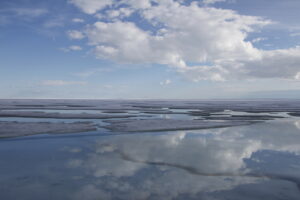
People & Culture
On thin ice: Who “owns” the Arctic?
As the climate heats up, so do talks over land ownership in the Arctic. What does Canadian Arctic Sovereignty look like as the ice melts?
- 4353 words
- 18 minutes
This article is over 5 years old and may contain outdated information.
Science & Tech

If you’re cold, say Inuit hunters, have a piece of seal meat — you’ll be amazed at how it warms you up from the inside. Meat from the nattiq (ringed seal) is a staple in Inuit coastal communities, and Inuit seamstresses are renowned for the unique boots, mitts, pants and jackets they create from its skin. Families also benefit from the income when these items are sold.
Inuit have been noticing some shifts in the abundance of ringed seals, and they’re keen to find out why. Are the numbers declining, or are the animals migrating elsewhere?
David Yurkowski, a University of Windsor PhD student at the Great Lakes Institute for Environmental Research, has broken new ground in his efforts to answer these questions. Working with Inuit hunters and other researchers in Resolute Bay, Nunavut, he’s been placing satellite tags on ringed seals to study their behaviour. “Behaviour is linked to abundance,” says Yurkowski. “With satellite tracking, we can see individual seal movements — dive behaviour, where they go, how they use their environment — in open water and under ice.”
Yurkowski’s work is part of the Ocean Tracking Network, which monitors marine species worldwide. His colleagues track ringed seals in Hudson Bay, the western Arctic, and Melville Bay, Greenland.
The results have surprised Inuit hunters and biologists alike. Previously believed to have a limited range, the new data shows that some seals tagged in Resolute Bay migrate long distances: four travelled 2,500 kilometres to southeast Baffin Island, and another covered 3,000 kilometres, swimming to Frobisher Bay via Greenland.
They behave differently in different areas, says Yurkowski, “and that’s probably linked to the availability of arctic cod, their main food. The Melville Bay population stays put because the nutrient-rich water from the glaciers there means high biological productivity — more food.”
The project has helped researchers develop an excellent relationship with the Inuit hunters. “They are central to our research because of their in-depth understanding of seals,” says Yurkowski. “They’re the Arctic experts.” For their part, the hunters are enthusiastic about the project’s discoveries and its potential to help answer their questions about the silver-grey seal that is so much a part of their culture and daily life.


Are you passionate about Canadian geography?
You can support Canadian Geographic in 3 ways:

People & Culture
As the climate heats up, so do talks over land ownership in the Arctic. What does Canadian Arctic Sovereignty look like as the ice melts?

Environment
The uncertainty and change that's currently disrupting the region dominated the annual meeting's agenda

Environment
Warming trends continue due to human-caused climate change

Environment
The Royal Norwegian Embassy and the Royal Canadian Geographical Society teamed up for two days of talks on the future of the Arctic and the “blue economy” in Norway and Canada